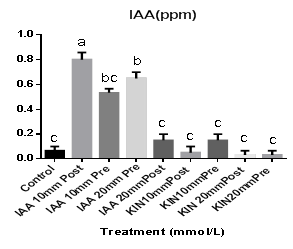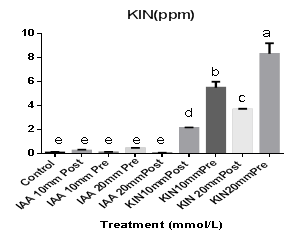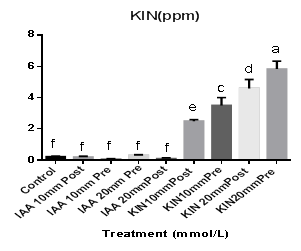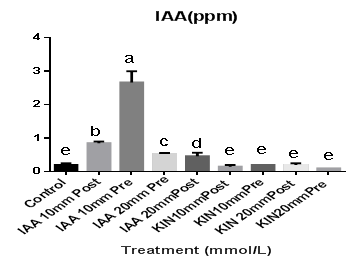Effects of Indole Acetic Acid and Kinetin on Physiological and Biochemical Properties of Two Cultivars of Pigeon Pea (Cajanus Caja. L)
Ailenokhuoria B. V1*, Orimadegun I. O2
1Agricultural Value Addition Programme, Institute of Agricultural Research and Training, Obafemi Awolowo University, P.M.B 5029, Moor Plantion Ibadan, Nigeria
2South West farming system Programme, Institute of Agricultural Research and Training, Obafemi Awolowo University, P.M.B 5029, Moor Plantion Ibadan, Nigeria
*Corresponding Author: Ailenokhuoria B.V, Agricultural Value Addition Programme, Institute of Agricultural Research and Training, Obafemi Awolowo University, P.M.B 5029, Moor Plantion Ibadan, Nigeria
Received: 01 February 2020; Accepted: 13 February 2020; Published: 20 February 2020
Article Information
Citation: Ailenokhuoria B. V, Orimadegun I. O. Effects of Indole Acetic Acid and Kinetin on Physiological and Biochemical Properties of two Cultivars of Pigeon Pea (Cajanus Caja. L). International Journal of Plant, Animal and Environmental Sciences 10 (2020): 027-034.
View / Download Pdf Share at FacebookAbstract
Pigeon pea is one of the most widely tropic and subtropic legumes grown for its seed. It is a lesser known legumes for improving health and nutrition of man, but limitation in utilization of this legume was as a result of low yield and, poor seed availaibity in addition to the presence of high amount of antinutrients and hard-to-cook phenomenon’ The present study was performed to know the effects of Indole acetic acid and Kinetin on the physiology and biochemical properties of pigeon pea. Seeds of Pigeon pea of two cultivars (CAJ324-15& CYJ728-42) were treated with 10mm & 20mm of Indole acetic acid (IAA) & Kinetin (KIN) either as pre-treatment or foliar treatment respectively. They were harvested at maturity and analysed for physiological (Chl a, Chl b and carotenoid, Number of seed/pod, Plant height, Fresh weight and Dry weight) and biochemical (IAA & KINETIN) properties. The results shows that there is significant difference in all the parameters examined as compared with control between the two varieties
Keywords
<p>IAA; KINETIN; Biochemical; Physiological; Pre- & Post-treatment</p>
Article Details
Abbreviation:
IAA; Indole acetic acid; KIN: Kinetin; Chl: Chlorophyll
1. Introduction
Pigeon pea (Cajanus caja. L) is a perennial legume from the family Fabaceae. It is common food in Asia, Africa and Latin America. It is also regarded as fast growing, hardy, widely adaptable, and drought resistant [1]. Cajanus caja either originate from North-Eastern Africa or India and its cultivation dates back at least 3000 years. It is regarded as a pantropical and subtropical species particularly appropriate for rainfed agriculture in semi-arid areas due to its deep taproot, heat tolerance and fast growing habit (and Mallikarjuna et al., 2011). It form an important food staple in many traditional diets that can improve public health and nutrition (Serrano et al., 2012). The seeds are valued worldwide as an inexpensive meat alternative and are considered the second most important food source after cereals (Kouris and Belska, 2016). The consumption rate surpasses production rate for some common legumes such as cowpea and soybean, so there is need to direct attention to the growth and development of various underutilized legumes, to increase the yield, utilization and production. However, several factors contribute to the limited use of these legumes. These include the low yield, poor seed availability and lack of marketingin addition to presence of anti-nutrients, bloating and flatulence which are particular to legumes as well as hard-to-cook phenomenon. Therefore there is need to improve upon these limitations to increase the production both at local and commercial farming hence this study on the effects of Indole acetic acid and Kinetin on physiological and biochemical properties of igeon pea. Indole acetic acid and Kinetin belong to classes of plant growth hormone that have been shown to regulate and promote plant growth and development. Indole acetic acid is a natural plant growth hormone belong to classes called auxin while kinetin is a type of synthetic plant growth hormone belong to class cytokinnin.
2. Material and Method
2.1 Seed materials
Two cultivars of Pigeon pea seed (CAJ324-15 & CYJ728-42) were obtained from Institute of Agricultural Research and Training Ibadan and were sorted out.
2.2 Preparation of IAA and Kinetin
10mm and 20mm of each of IAA and Kinetin was prepared according to the methods of R. Coolbear. And W. Heydecker. (1997) with slight modification.
2.3 Seed /Plant Treatment
For pre-treatment of the seed, each of the two cultivars of the seed was treated with 10mm & 20mm of IAA and Kinetin respectively in a clean container. Distilled water was used instead of hormones for other part of the seeds which represent control while for post-treatment, foliar method was done 4weeks after planting and this was repeated twice until maturity.
2.4 Estimation of Photosynthetic Pigments
The photosynthetic pigments estimated (chlorophyll a, chlorophyll b and carotenoids) were estimated spectrophotometric according to the method of (Ricardson et al., 2002). The concentrations of chlorophyll a, chlorophyll b, and total Carotenoids were determined using Arnon's equation (1949).
Chlorophyll a = 10.3 E663-0.918E644 = mg/ml
Chlorophyll b = 19.7E644-3.870E663 = mg/ml
Carotenoids = 4.2 E452-(0.0264 chlorophyll a + 0.426 chlorophyll b) = mg/ml
2.5 Estimation of Physiological Parameters
Fresh weight, Dry weight, Number of seed/Pod, Percentage germination and Plant height was determined according to modified methods of Singh and Gosh (2010).
3. Estimation of Phytohormones
3.1 Extraction of phytohormones
IAA and Kinetin was extracted from the fresh plant according to the method of Marrillia et al., 2014 using 1mlof methanol and water (8:2).
3.2 Determination of phytohormone concentration
Concentration of phytohormones was determined according to the modified method of Parth et al., 2014. Standard each of IAA and Kinetin was prepared in 0.01ppm, 0.1ppm, 1ppm, 10ppm and 100ppm. The concentration of IAA and Kinetin was measured using UV spectrophotometer at absorbance of 254nm and 535nm respectively and result was calculated from calibration curve.
3.3 Statistical Analysis
Data were analysed using statistical software (SAS). Means were separated using Duncan Multiple Range Test at P<0.05 level of significance.
4. Results
|
Treatment mg/L |
Chl a mg/L |
Chl b mg/L |
Car mg/L |
|
Control |
1.88 ± 0.003b |
0.12 ± 0.002gh |
0.30 ± 0.001e |
|
IAA 10mm Post |
0.82 ± 0.002g |
0.20±0.002f |
0.11 ± 0.002h |
|
IAA 10mm Pre |
1.15 ± 0.002e |
0.69±0.011a |
0.48 ± 0.003c |
|
IAA 20mm Pre |
0.77 ± 0.001h |
0.26±0.006e |
0.13 ± 0.002g |
|
IAA 20mm Post |
0.66 ± 0.001i |
0.14±0.002g |
0.09 ± 0.002i |
|
KIN 10mm Post |
1.63 ±0.003c |
0.42±0.001c |
0.59 ± 0.003b |
|
KIN 10mm Pre |
2.57 ±0.003a |
0.30±0.005d |
0.99 ±0.002a |
|
KIN 20mm Post |
1.37 ±0.002d |
0.11±0.003h |
0.17 ±0.001f |
|
KIN 20mm Pre |
0.90 ±0.001f |
0.63±0.002b |
0.39 ±0.002d |
Values are Mean±standard error, Means with the same letter are not significantly different from each other
Table 2: Effect of IAA and Kinetin on Growth Parameters of CAJ324-15
|
Treatment mg/L |
Number of seed/Pod |
Plant height(cm) |
Fresh weight(g) |
Dry weight(g) |
|
Control |
101.00±0.577b |
96.67 ± 1.202b |
0.67±0.012c |
0.26 ± 0.006bc |
|
IAA 10mm Post |
50.67±0.667e |
56.00 ± 0.577e |
0.43 ±0.006f |
0.18 ± 0.006e |
|
IAA 10mm Pre |
84.00±0.577c |
77.00 ± 0.577c |
0.56 ±0.003d |
0.15 ± 0.006f |
|
IAA 20mm Pre |
20.00±1.000h |
31.50 ± 0.500f |
0.33± 0.010h |
0.23 ± 0.015d |
|
IAA 20mm Post |
46.50±0.500f |
57.50 ± 0.500e |
0.37±0.010g |
0.24 ± 0.010cd |
|
KIN 10mm Post |
65.00±1.000d |
121.00 ±1.000a |
0.72 ± 0.010b |
0.36 ± 0.015a |
|
KIN 10mm Pre |
161.00±1.000a |
120.50 ± 0.500a |
0.89 ± 0.005a |
0.28 ± 0.005b |
|
KIN 20mm Post |
52.33±1.453e |
66.00 ± 0.577d |
0.53 ± 0.009e |
0.25 ± 0.003bc |
|
KIN 20mm Pre |
44.33±0.667g |
64.00 ±0.577d |
0.52± 0.006e |
0.22 ± 0.009d |
Values are Mean±standard error, Means with the same letter are not significantly different from each other
Table 3: Effect of IAA and Kinetin on Photosynthetic Pigments of CYJ728-42
|
Treatment mg/L |
Chl a (mg/L) |
Chl b (mg/L) |
Car (mg/L) |
|
Control |
1.12 ± 0.002e |
0.01 ± 0.002k |
0.07 ± 0.001i |
|
IAA 10mm Post |
0.92 ± 0.002h |
0.12 ± 0.001j |
0.14 ± 0.002h |
|
IAA 10mm Pre |
0.92 ± 0.001g |
0.76 ± 0.002d |
0.56 ± 0.001b |
|
IAA 20mm Pre |
0.95 ± 0.001f |
0.42 ± 0.001e |
0.26 ± 0.001e |
|
IAA 20mm Post |
1.27 ± 0.002c |
0.16 ± 0.001i |
0.18 ± 0.002g |
|
KIN 10mm Post |
1.64 ± 0.002a |
0.21± 0.002f |
0.27 ± 0.001d |
|
KIN 10mm Pre |
1.23 ± 0.002d |
0.92 ± 0.003b |
0.71 ± 0.001a |
|
KIN 20mm Post |
1.45 ± 0.002b |
0.17 ± 0.002h |
0.21± 0.002f |
|
KIN 20mm Pre |
0.89 ± 0.002i |
0.85 ± 0.001c |
0.53 ± 0.006c |
Values are Mean±standard error, Means with the same letter are not significantly different from each other
Table 4: Effect of IAA and Kinetin on Growth Parameters of CYJ728-42
|
Treatment mg/L |
Number of seed/pod |
Plantheight(cm) |
Fresh Weight(g) |
Dry Weight(g) |
|
Control |
42.00 ±0.580f |
68.00 ± 0.58d |
0.71 ± 0.012b |
0.17 ± 0.009c |
|
IAA 10mm Post |
40.33±0.880fg |
51.33 ± 0.33 g |
0.48 ± 0.006 e |
0.13 ± 0.006de |
|
IAA 10mm Pre |
78.33±0.333b |
87.67 ± 0.33b |
0.52 ± 0.006d |
0.18 ± 0.006c |
|
IAA 20mm Pre |
86.50±0.500a |
68.50 ± 0.50d |
0.23 ± 0.010h |
0.13 ± 0.015e |
|
IAA 20mm Post |
48.50±0.500cd |
62.50 ± 0.50e |
0.27 ± 0.010g |
0.19 ± 0.005c |
|
KIN 10mm Post |
46.50± 0.500de |
57.50 ± 0.50f |
0.77 ± 0.015a |
0.37 ± 0.010a |
|
KIN 10mm Pre |
38.50 ± 0.500g |
75.50 ± 0.50c |
0.79 ± 0.005a |
0.18 ± 0.005c |
|
KIN 20mm Post |
40.00 ± 0.577fg |
47.00 ± 0.58h |
0.61 ± 0.012 c |
0.22 ± 0.007b |
|
KIN 20mm Pre |
46.00±0.577e |
96.00 ± 0.58a |
0.42 ± 0.006f |
0.22 ± 0.009b |
Values are Mean±standard error, Means with the same letter are not significantly different from each other
4. Discussion
Table 1 and 2 shows that there is significant difference in the level of Chl a, Chl b and carotenoid, Number of seed/pod, Plant height, Fresh weight and Dry weight for all the treatment applied as compared with control except treatment with KIN 20mm Post for CAJ324-15 which show no significant differences as compared with the control. Also, among the IAA and KIN foliar method and pre-treatment, IAA 10mm Pre and KIN 10mm Pre show highest mean value for chl a. b and carotenoid respectively. Also for CYJ728-42, Table 3 and Table 4 show that only IAA 20mm Post, KIN 10mm Post, KIN 10mm Pre and KIN 20mm Post show significance difference with respect to control for Chl a, while IAA, KIN for both 10mm and 20mm Pre & Post only show significance difference with respect to control for Chl b and carotenoids while only IAA 10mm & 20mm Pre, 20mmPost, KIN 10mm Post, KIN 20mmPre is significant different with respect to control for Number of seed/pod, only IAA 10mm Pre, KIN10mm Pre & KIN 20mm Pre show significance difference with respect to control for plant height, KIN 10mm Pre & Post only show significance difference with respect to control for Fresh weight, KIN 10mm Post, KIN 20mm Pre & Post only show significance difference with respect to control for dry weight. This means these concentration is most suitable for higher growth and production hence accelerating the nutrients uptake that is responsible chlorophyll formation. In addition, Figure 1 and 2 shows that there is significant difference for both IAA and KIN concentration in all the treatment applied as compared to the control except for IAA 10mm Pre which show no significant difference as compared with the control. The highest mean value for IAA and KIN concentration wasfound in treatment IAA 10mm Post and KIN 20mm Pre respectively. Moreover, Figure 3 and 4 show that only IAA 10mm and 20mm for both Pre and Post show significance difference with respect to control for IAA treated group while for KIN treated group, only KIN 10mm and 20mm Pre & Post show significance difference with respect to control. This was as a result of their inductive effects which therefore upregulate the level of each endogenous phytohormone respectively. Also the implication of the upregulation was observed in their physiological and biochemical composition which is an indication of positive response to both pre and post-treatments this was also in accordance with the work of Mukhtar 2008 on which reported that 100ppm IAA and 100ppm GA3 improve growth and nutritional value of Hibiscus sabdariffa L. (Red sorrel). Mona et al., 2013 also reported the promoting effect of foliar application of IAA and NAA on physiological and biochemical parameters of barley.
However, despite these plant growth hormones (indole acetic acid and kinetin) induce and accelerate growth in plant via different mechanism for instance IAA which is an endogenous or natural hormone serve to promote root formation and kinetin, an example of synthetic hormones serve to promote shoot elongation, it must be emphasized they conforms to general mechanisms of bioregulators in which there is promoting effects at low concentration but inhibitory effects at high concentration (El-al and Faten, 2009).
5. Conclusion
The present work show that the co application and pre-treatment of Pigeon pea with indole acetic acid and kinetin could promote both physiological and biochemical properties hence resulting to enhanced growth and productivity. However, this study show that response of pigeon pea to either pre- and post-treatment of indole acetic acid and kinetin solely depend on concentration applied and cultivars of the seed.
References
- Richardson AD, Duigan SP, Berlyn GP. An evaluation of noninvasive methods to estimate foliar chlorophyll content. New phytologist 153 (2002): 185-194.
- Bekele A. Profitable Agroforestry innovation for Eastern Africa: experience from 10 agroclimatic zones of Ethiopia. India, Kenya, Tanzania and Uganda, world agroforestry center (2007).
- Khoury CK, Castañeda-Alvarez NP, Achicanoy HA, et al. Crop wild relatives of pigeonpea [Cajanus cajan (L.) Millsp.]: Distributions, ex situ conservation status, and potential genetic resources for abiotic stress tolerance. Biological Conservation 184 (2015): 259-270.
- Mukhtar FB. Effect of some plant growth regulators on the growth and nutritional value of Hibiscus sabdariffa L.(Red sorrel). International Journal of Pure and Applied Sciences 2 (2008): 70-75.
- Mallikarjuna N, Senapathy S, Jadhav DR, Saxena K, et al. Progress in the utilization of Cajanus platycarpus (Benth.) Maesen in pigeonpea improvement. Plant Breeding 130 (2011): 507-514.
- Almeida Trapp M, De Souza GD, Rodrigues-Filho E, et al. Validated method for phytohormone quantification in plants. Frontiers in plant science 5 (2014): 417.
- Mona EE, Maymona AK, Ibrahim SA. Response of barley plants to foliar application of growth regulators mixture of indole acetic acid, naphthalene acetic acid and zinc. African Journal of Biotechnology 12 (2013).
- Bhatt PV, Vyas BR. Screening and characterization of plant growth and health promoting rhizobacteria. Int. J. Curr. Microbiol. App. Sci 3 (2014): 139-155.
- Sushant KS, Ghosh AK. Effect of Arsenic on Photosynthesis, Growth and its Accumulation in the Tissues of Allium cepa (Onion). International Journal of Environmental Engineering and Management 1 (2010): 39-50.
Article Views: 1198
Journal Statistics




Discover More: Recent Articles
Grant Support Articles
© 2016-2026, Copyrights Fortune Journals. All Rights Reserved!






